February 22nd 2019 1:10 pm | by Svetlana Pantelic | Posted in Blog
Items of personal adornment from the Nile Valley are an important part of the history of jewelry. More than mere body ornament, Ancient Egyptian Jewelry was used to display rank, proclaim wealth, and designate social status. It was also fashioned into powerful amulets, objects of barter and trade, accouterments of daily attire, diplomatic gifts, military honors, and propagandistic tools.
Most valuable are ornaments recovered during excavations. Another important resource exists in the detailed recording of jewelry and jewelry-making in sculpture, and reliefs. In fact, some ornaments, such as the heart-shaped pendant are known exclusively from representations.
The more common, however, is an inability to match a known jewel with an ancient picture. For example, with Tutankhamun were buried numerous finger rings and ear ornaments, yet the young king was never depicted wearing either form of jewelry.
Texts also supply essential insights into the materials, forms, manufacture, and purposes of Ancient Egyptian jewelry.
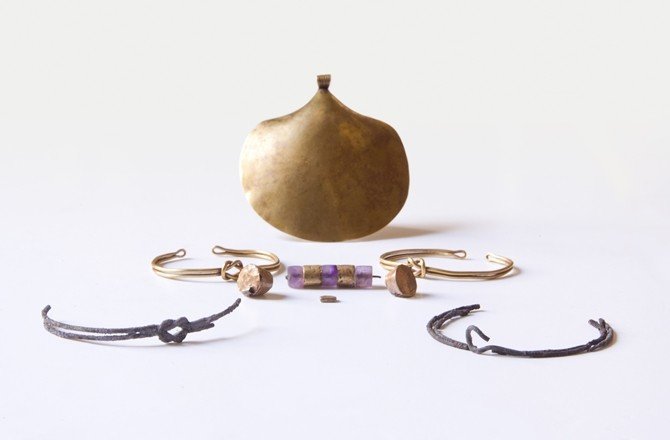
Spanish archaeologists digging in Egypt have unearthed a female mummy still wearing her jewels. A 4000-year-old, bejeweled mummy is discovered below a temple in Luxor. Belonging to a higher social class, the woman, possibly in her 30s, was buried with a necklace in which semiprecious stones and gold plates alternate. A pendant in the form of a finely-wrought golden shell weighing over 20 grams was attached.
A wide range of materials was available to the ancient jeweler, and those selected were chosen for aesthetic, practical, and symbolic reasons. Symbolism was particularly significant since the bulk of ancient Egyptian jewelry worn in ancient Egypt served amuletic ends.
Gold, considered “the flesh of gods,” was valued for its inherent properties of sun-like brilliance, malleability, and resistance to corrosion. Egypt had deposits of this precious metal, which was eagerly sought by all strata of society.
Silver had to be imported from the Near East and Aegean. A manifestation of the” bones of gods,” silver symbolized the moon and the lotus blossom, a flower that defeats darkness and death as it opens under the warming rays of the morning sun.
While casting was known metalworking technique in ancient Egypt, ornaments of precious metal were more likely to be fabricated from hammered sheet metal, which was cut, shaped, and joined through crimping and or soldering.
Wirework was primarily accomplished through strip twisting, as the draw-plate was not available until the Roman period.
Hand wrought wires were used securing beads and amulets, chain-making, as well as decorating metal surfaces.
For jewelry designed exclusively for burial, the metal was often quite thin, as the jewels of the deceased were not subjected to the wear of daily life.
Gilding was also used to enhance less costly materials such as wood, steatite, and faience.
The stones most prized for ancient Egyptian jewelry are carnelian, green feldspar or amazonite, turquoise, and lapis lazuli. Other stones – malachite, calcite, banded agate, porphyry, olivine, fluorspar, rock crystal, obsidian, hematite, jasper (red and green), and serpentine – were used less frequently.
Changing tastes and availability may have influenced the use of some stones – for example, amethyst was thought to be fashionable during the Middle Kingdom, while peridot and emerald, obtained from the Red Sea area, were not incorporated into ancient Egyptian jewelry until the Ptolemaic period.
Most stones, however, were selected for their hardness, rarity, and color. In antiquity, the color was synonymous with essence – the red-orange carnelian symbolized power and dynamism; the green of amazonite and turquoise represented regenerative growth, and the brilliant blue lapis lazuli was associated with the heavens and the life-giving Nile.
By the Old Kingdom, the tricolor scheme of red, blue/green, and deep blue had been established for royal and country jewels.
These hard gemstones were used to make a variety of ornaments, including beads, amulets, and pendants. These forms constitute the most popular items of adornment in the ancient world.
Those who could not afford the hard, colored stones for jewelry used steatite (soapstone), a readily available soft stone that was easy to carve and that was more than a practical matter, as the Egyptians Equated this property with endurance and longevity.
Organic substances were utilized for objects of adornment from the earliest of times. Flowers, seeds, shells and plant fibers were easily manipulated and accessible to all members of society.
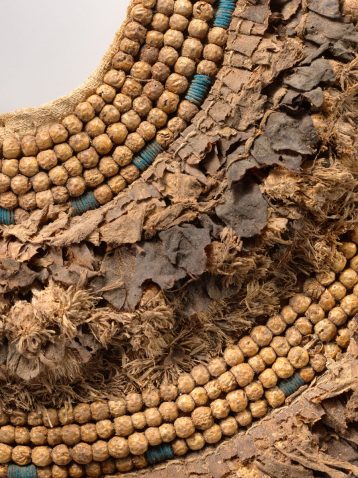
Floral Collar from Tutankhamun’s Embalming Cache. The New Kingdom. This remarkably preserved floral collar, from the funerary cache of Tutankhamun, was probably worn at a funeral banquet. Alternating rows of flower petals and blossoms, leaves, berries, and blue faience beads were sewn to a papyrus backing, and linen ties secured the collar around the wearer’s neck. Some of the flora used in the Tutankhamun collars has been identified as olive leaves, cornflowers, and poppies. Papyrus, olive leaves, Persea leaves, cornflowers, blue lotus petals, Picris flowers, nightshade berries, faience, linen.
Ivory, obtained from the tusks of the elephant and hippopotamus, was valued for its rarity, symbolism and visual appeal. From this soft material, Egyptians made hairpins, finger rings, bangles, cuffs, ear ornaments, amulets, and beads. It was also used as an inlay material.
Pearls were not in Egypt until the Ptolemaic period, although the mother-of-pearl from the Red Sea oyster exploited for bangles, rings, ear ornaments, and beads.
Probably the most commonly used material used for Ancient Egyptian jewelry was faience – non-clay, quartz-based, glazed ceramic that could be modeled by hand and shaped in a mold.
Egyptians believed that faience possessed magical properties, based on the dramatic transformation – from dull, white paste to a glimmering substance – that takes place during heating.
Faience is similar to glass; only glass has fewer impurities and requires a higher firing temperature. The most ubiquitous of glass ornament are beads. One particular bead, the stratified “eye” bead, was developed in Egypt during the reign of Thutmose III. The talismanic blue “eye” bead produced in the Middle East today has its origin in ancient Egypt.
Ancient Egyptians made a clear division between the “fine” and “applied” arts. The most esteemed artists were sculptors and architects. Of lesser influence were skilled painters, followed by outline craftsmen.
At the opposite end in rank and status were craftsmen who created objects of daily life, and their makers failed to achieve the recognition reserved for large-scale work.
The jewelers of Dynastic Egypt are known to us from relief, paintings and stelae.
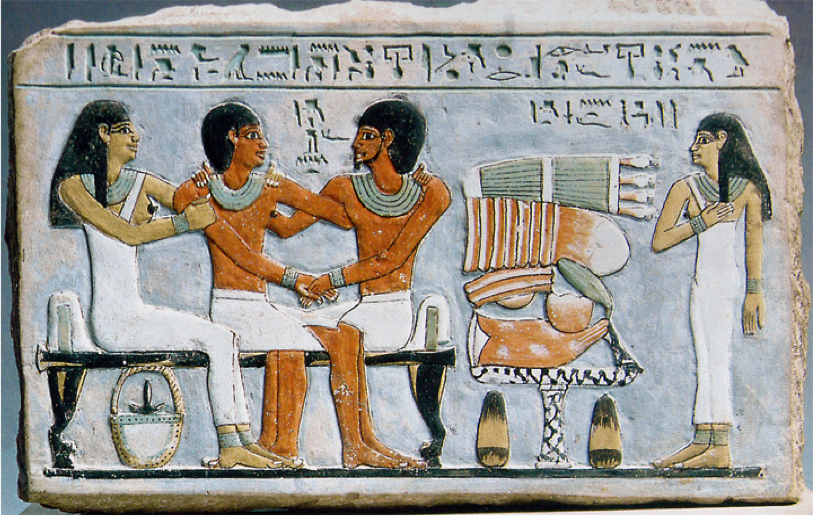
Wall painting from the tomb of Sobekhotep. 18th Dynasty, Thebes. Limestone wall-painting: in two registers, depicting the activities of jewelry-makers and precious-metal workers. Beads are being bored with quadruple and triple bow-drills.
Although ancient Egyptian jewelry is admired for its aesthetic appeal and craftsmanship, it is the striking and exceptional nature of its iconography that sets it apart from the ornaments of other cultures. Egypt was one of the few societies in world history that did not establish sumptuary laws limiting the use of certain materials to elites.
It was generally made of beaded rows and shaped like flowers or animals. The collar was stretched over the wearer from breast to collarbone. It was also common for pendants to be strung on beaded necklaces, bearing an amulet of protection.
There were two basic types: wsh (“the broad one”) and the šnw collar (“that which encircles”).
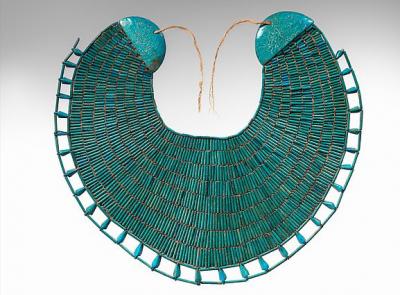
This broad collar is one of the finest examples of its type from the early Middle Kingdom. It was carefully designed using beads of diminishing lengths to create the curved form. Known as a wesekh (wsh) in ancient Egyptian, this type of necklace adorns statues, coffins, and participants in banquet and offering scenes from the Old Kingdom on. This collar is part of a set of funerary jewelry belonging to Wah, the estate manager of Meketre.

The Broad collar of Senebtisi. Senebtisi was an Ancient Egyptian woman who lived at the end of the 12th Dynasty, Middle Kingdom around 1800 BC. She is only known from her undisturbed burial found at Lisht. Falcon heads and leaf pendants originally gilded plaster, restored in gilded silver. Eyes originally gilded beads restored in gilded plaster. It was made of faience, gold, carnelian, turquoise.
The writing of names was particularly important in that the act of setting one’s name in a lasting, magical material insured the wearer against decay and destruction. Although nonroyal names and titles are known to exist, most ornaments with text feature divine or royal names. For the ordinary person, a jewel with the name of the deity or king guaranteed the wearer’s protection. In this category fall such magical signs as the:
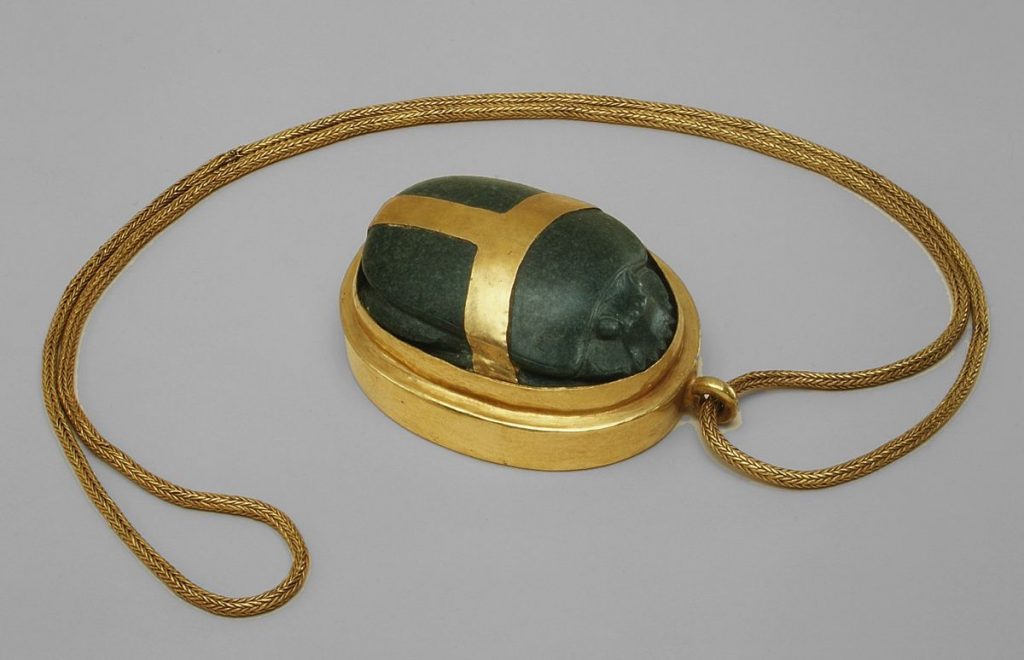
Heart Scarab of Hatnefer, New Kingdom. Gold, Serpentinite. Hatnefer’s heart scarab is an exceptionally fine example of this type of funerary equipment and is comparable to those made for contemporary royalty. Every feature of the scarab beetle is carefully rendered. The exquisite chain is made of gold wire, plaited in a quadruple-link pattern.
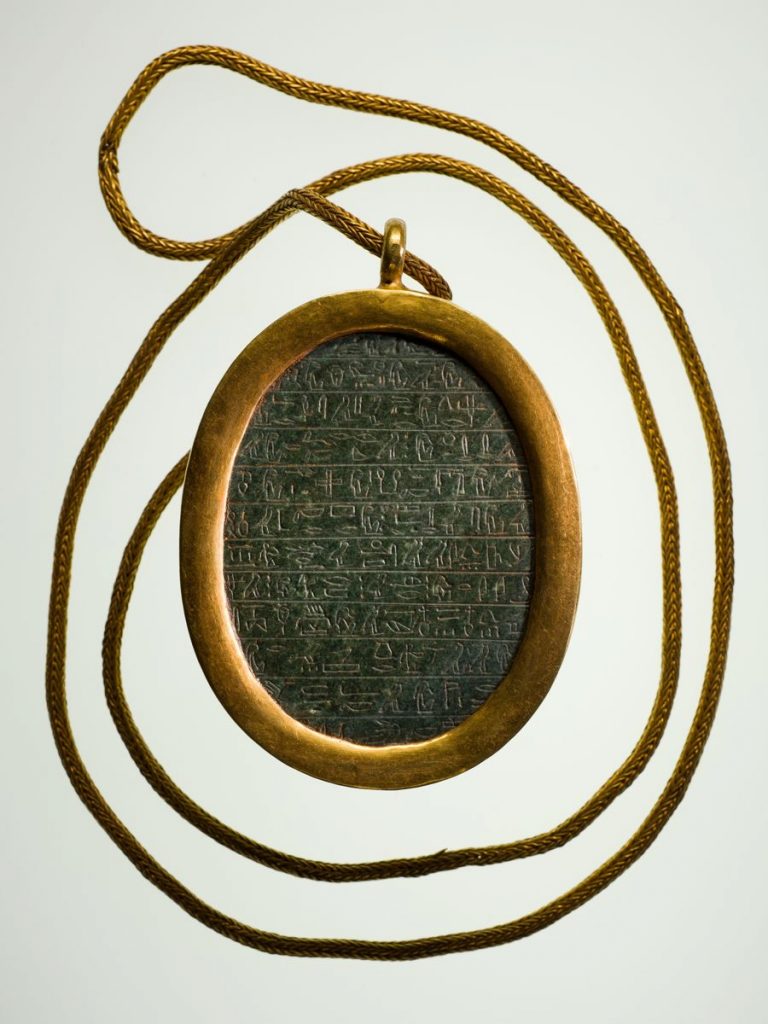
The scarab’s base is engraved with a version of Book of the Dead chapter A, in which the deceased addresses her own heart, exhorting it not to bear witness against Hatnefer’s spirit (ka) during the final judgment in the afterlife. In the top line, Hatnefer’s name was inserted over an erased text, indicating that the scarab was not originally made for her.
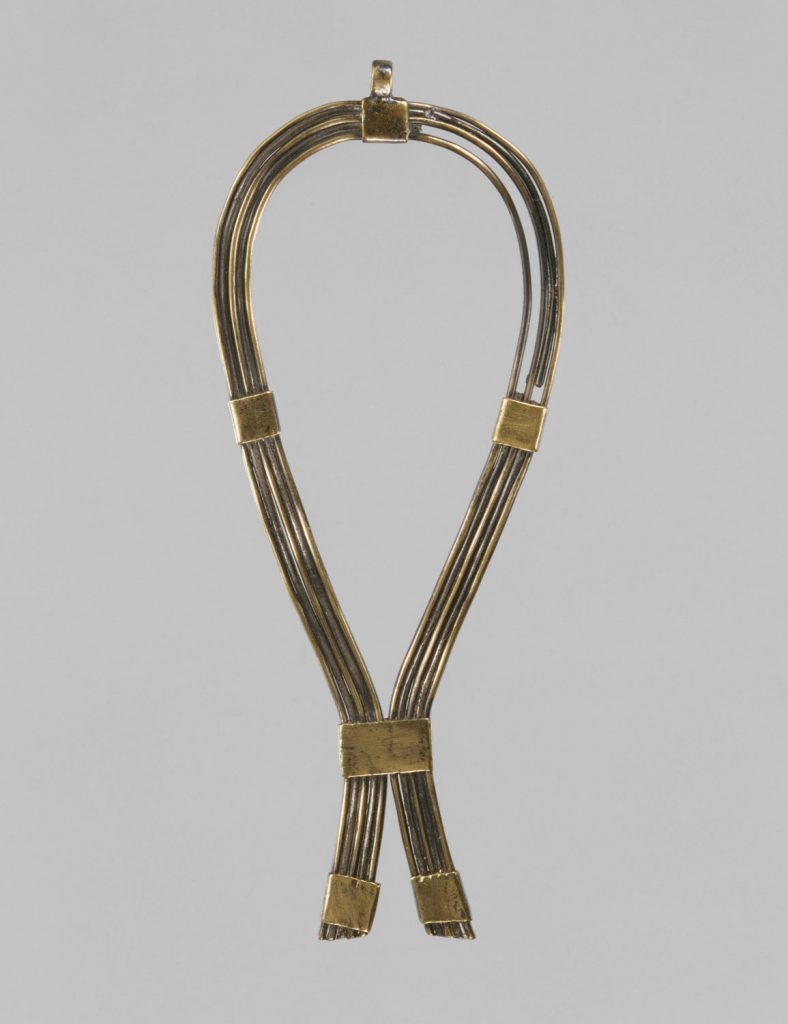
Sa Amulet from the Middle Kingdom. Silver, electrum. This amulet depicts the hieroglyph that writes the word “sa,” which means protection. The Sa amulet thus extends protection to the wearer, whether in life or death.
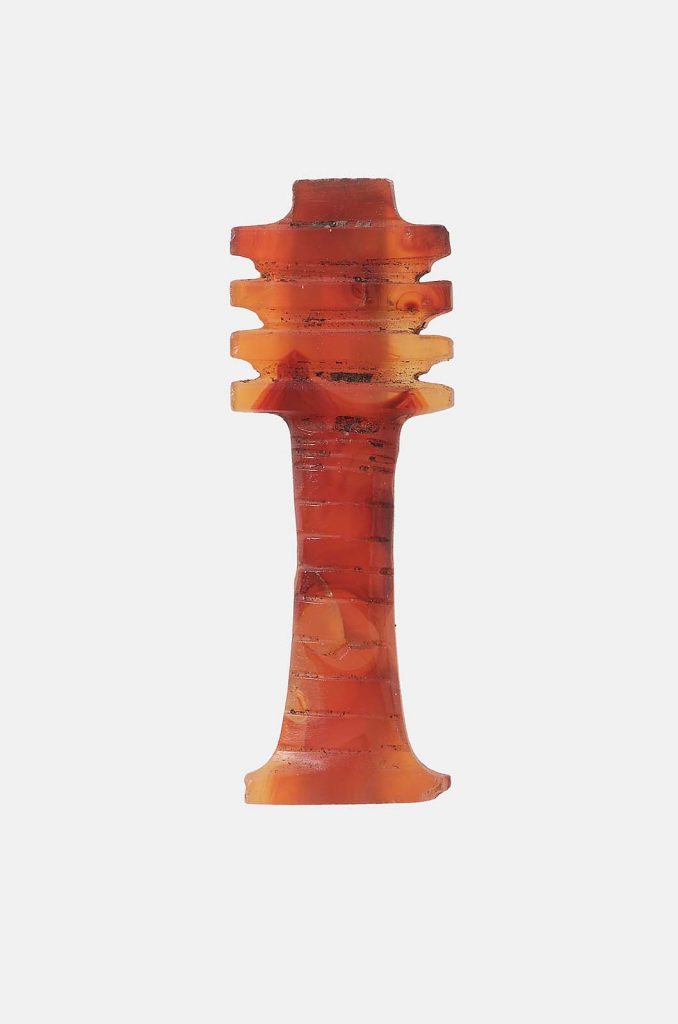
Amulet of djed pillar from the Late Period. Carnelian. The amulet represents the djed-pillar. The pillar, which symbolized the spinal column of the funerary god Osiris, was the hieroglyphic symbol for stability.
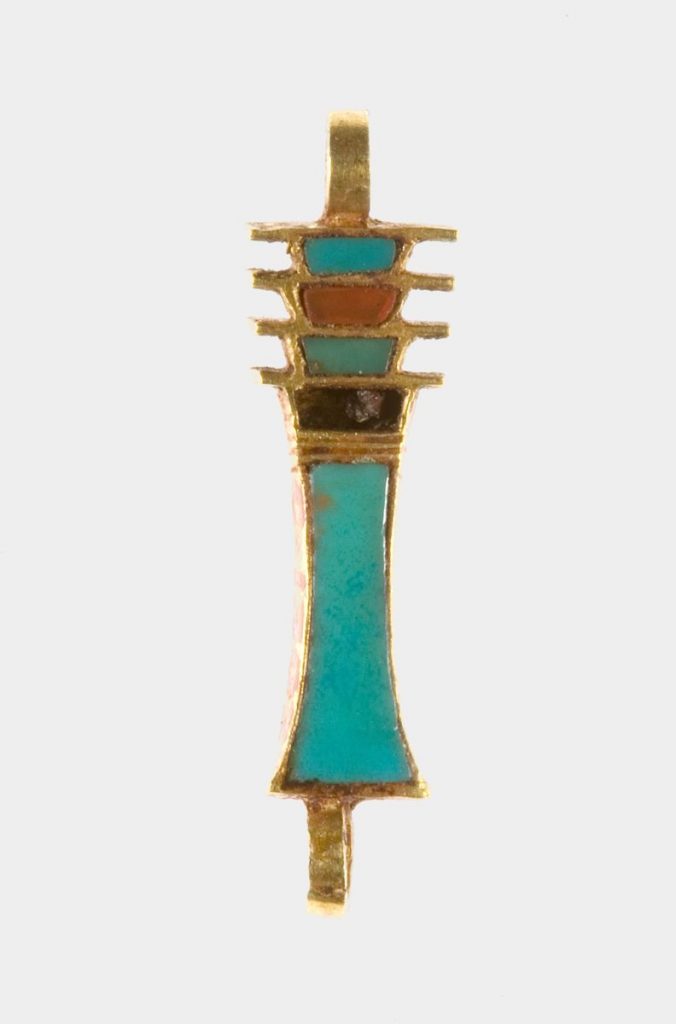
Ancient Egyptian Jewelry element in the form of a djed pillar. The Middle Kingdom. Gold, carnelian, turquoise, lapis lazuli

This pendant amulet is of a wedjat eye represents Horus’ left eye lost in battle and later restored magically by Hathor. The eye came to symbolize wholeness.

Beaded collar with amulets, Middle Kingdom. The central motif of this small, elegant collar, is a large, hollow gold ball bead flanked by a pair of amulets in the form of wadjet eyes, one of the most popular and powerful amulets for warding off potential threats. Centrally placed on each side of the main motif is an openwork amulet representing Heh (the one on the left is very small), the personification of “infinity,” portrayed as a kneeling man holding the hieroglyphic symbol for “year” in each of his hands. These amulets, it was hoped, would help to ensure an infinite life in the hereafter. On the left side, the Heh amulet stands between two additional wadjet eyes. On the right side are a sphinx and a falcon, both emblems of the cosmic power associated with the sun god and the king. The rest of the collar consists of four rows of delicately crafted, blue-glazed disk beads linked by gold spacer beads.
The craftsmen of the Middle Kingdom produced some of the finest ancient Egyptian jewelry. Both men and women wore broad collars, as they had in the Old Kingdom, and now amulets became an important element of their design.
Although the beaded collar remained a staple ofAncient Egyptian jewelry, collars were sometimes worn with pendants.
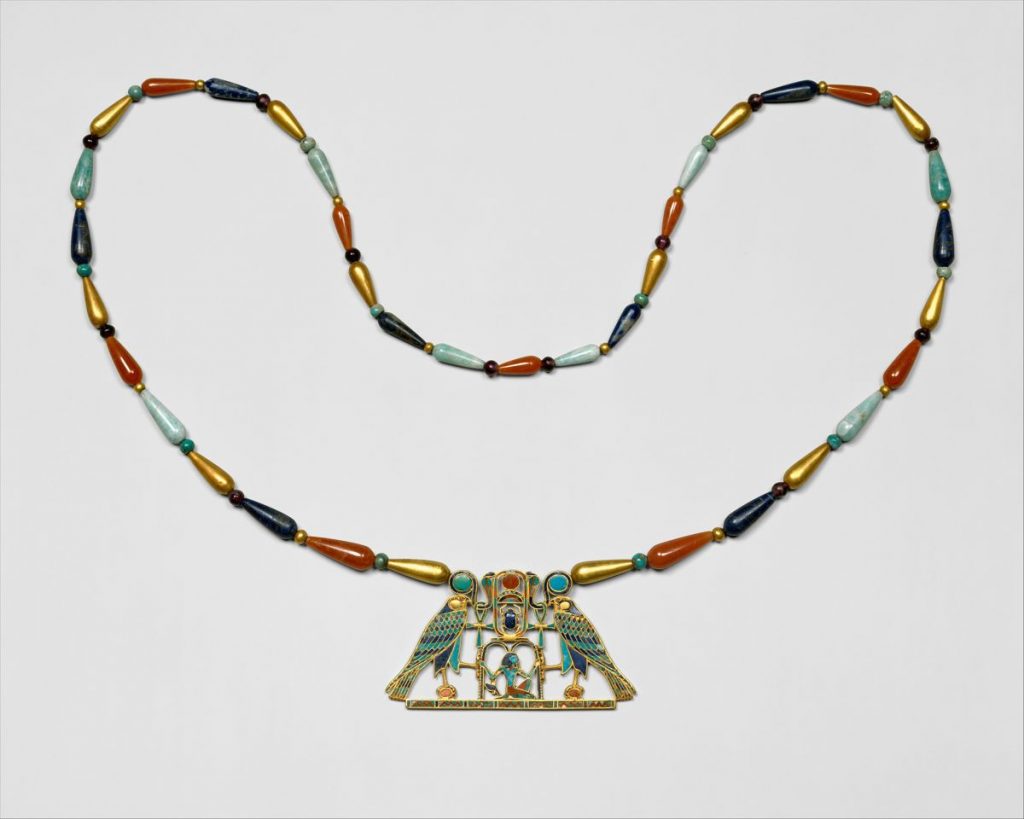
Pectoral and Necklace of Sithathoryunet with the Name of Senwosret II, a pharaoh from the Middle Kingdom. Gold, carnelian, lapis lazuli, turquoise, garnet (pectoral). Gold, carnelian, lapis lazuli, turquoise, green feldspar (necklace).
Ear ornaments were worn by both sexes, although women are more frequently shown wearing them. For some reasons, kings were not depicted wearing this type of adornment.
The earliest rings appear to be plain wires, worn on several fingers of each hand. The scarab was sometimes threaded onto the wire.
By the New Kingdom, rings for elites were elaborate constructions with bezels occasionally incorporating miniature sculptures of horses, divinities, and sacred animals.
Less ornamental but more affordable was the stirrup signet ring, typically cast in multipart molds.
Egyptians frequently wore jewelry on their wrists, arms, and ankles. Less formal arrangements consisted of rings of beads and amulets, while more traditional decorations were part of coordinated parures, composed of a beaded collar, wrists, armlets, and anklets.
One element that could be added to the latter was the ornamental clasp.
Clasps were often made of sheet metal an inlaid with gemstone. Their design encompassed hieroglyphic signs, symbols, and emblems.
Like most ancient Egyptian jewelry, armlets were worn by both sexes but with less frequency than wrist ornaments. The reason for this may partly reside with practical problems posed by body movement and gravity. Armlets need to fit firmly on the upper arm to prevent slipping.
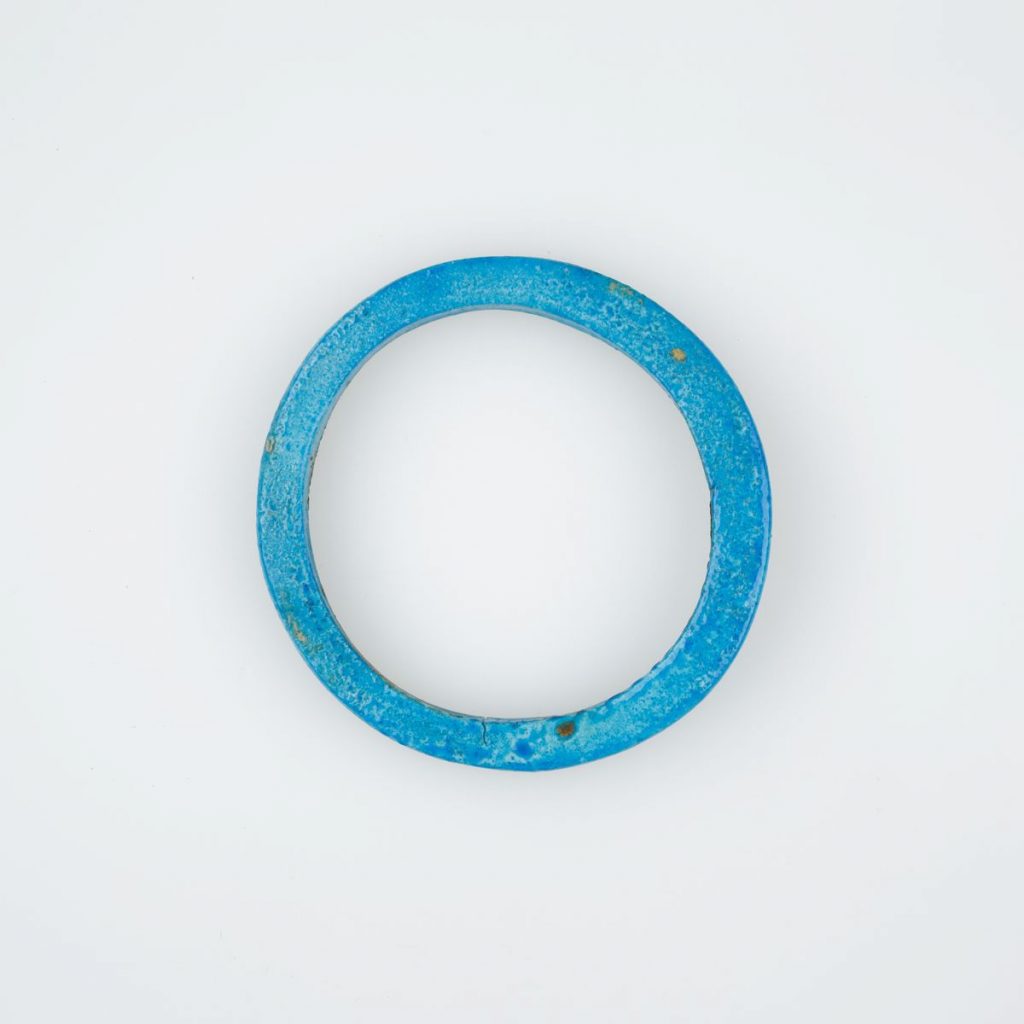
Armlet of Amenhotep, New Kingdom. Inside the coffin of the child Amenhotep, two faience armlets had been placed on either side of the mummy’s head. These wide bands were made to be worn on the upper arm of a grown man, not a child, and they may have been a parting gift from the boy’s father.
There appears to be less variety of anklets, although one form – the anklet with claws – protected female wearers against scorpion bites.
Protective amulets could be worn as independent pieces, but they were often fused into Egyptian jewelry. These amulets were talismans or charms that were believed to either infuse the amulet with power or to protect the wearer. The amulets were carved into various shapes and forms, including symbols, humans, animals, and gods. Additionally, the amulets were seen as equally significant protectors of the living and the dead. Amulets were made specifically for the afterlife, as memorial jewelry was customary for ancient Egypt.
Beaded necklaces were also popular amongst ancient Egyptian jewelry. These necklaces often featured amulets and charms and were made from varying sizes and shapes of beads. The beads were made from minerals, semi-precious stones, clay, and glass.
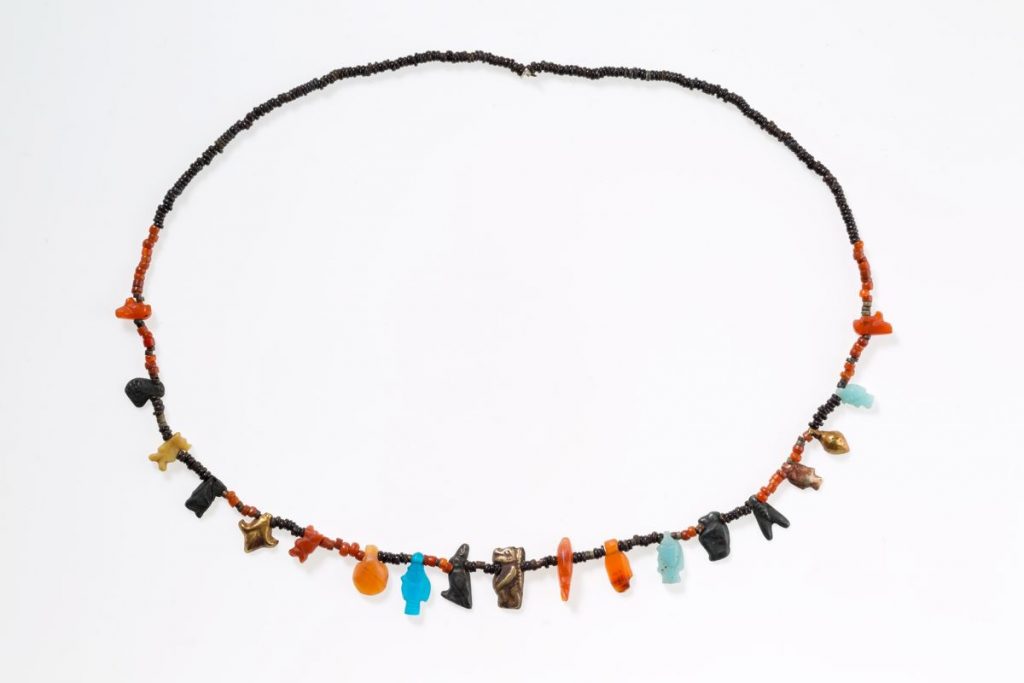
Necklace with disc beads and amulets from the New Kingdom. This necklace is composed of tiny disk beads interspersed with a variety of amulets, including falcons, a frog, Tawerets, a lotus, bolti fish, a shell or bullae, a hand, and a “nefer” sign. Some amulets, such as the lotus, frog, and fish, symbolize fertility, while Taweret and the falcon offer protection. The “nefer” hieroglyph conveys a good wish. This necklace was one of three stored in a small jewelry box in a man’s burial. Carnelian, gold, silver, faience, glass, yellow stone, tin
Egyptians were deep believers in jewelry’s spiritual significance. It was worn to ward off evil spirits, protect their health, as well as bring good luck. Certain colors, designs, and materials were associated with supernatural powers and deities. Carnelian, for example, is an orange-red stone which was suggestive of blood- this infused an ornament with potency and energy. Egyptian jewelers followed very strict rules regarding the mystical aspects of their jewelry creations.
The Egyptians wore their jewelry in life and in death as many pieces were entombed with them during burials. Egyptians were greatly addicted to the wearing of jewelry.
If you love jewelry as much as they did, please view our collection of jewelry.